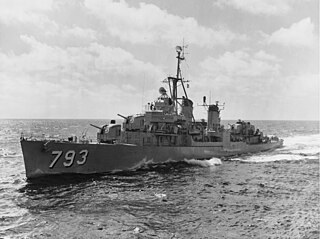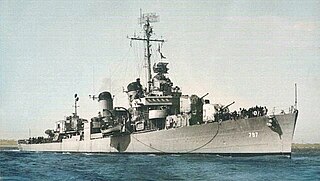
USS Pensacola (CL/CA-24) was a cruiser of the United States Navy that was in service from 1929 to 1945. She was the lead ship of the Pensacola class, which the navy classified from 1931 as heavy cruisers. The third Navy ship to be named after the city of Pensacola, Florida, she was nicknamed the "Grey Ghost" by Tokyo Rose. She received 13 battle stars for her service.

USS Santa Fe (CL-60), a Cleveland-class light cruiser, was the first ship of the United States Navy to be named for the city of Santa Fe, New Mexico.

USS Makin Island (CVE-93) was a Casablanca-class escort carrier of the United States Navy. It was named for the 1942 Makin raid, an early diversionary raid designed to distract from the Guadalcanal campaign and the Tulagi campaign. Launched in April 1944, and commissioned in May, she served in support of the Philippines campaign, the Invasion of Iwo Jima, and the Battle of Okinawa. Postwar, she participated in Operation Magic Carpet. She was decommissioned in April 1946, and ultimately sold for scrapping in January 1947.

USS Miami was one of 27 United States Navy Cleveland-class light cruisers completed during or shortly after World War II. The ship, the second US Navy ship to bear the name, was named for the city of Miami, Florida. Miami was commissioned in December 1943, and saw service in several campaigns in the Pacific. Like almost all her sister ships, she was decommissioned shortly after the end of the war, and never saw active service again. Miami was scrapped in the early 1960s.

USS Mobile (CL-63) was a Cleveland-class light cruiser of the United States Navy. She was the third ship named for Mobile, Alabama.

USS Oakland (CL-95), was a modified Atlanta-class light cruiser, the first of a group of four sometimes referred to as the "Oakland-class". She was laid down by Bethlehem Shipbuilding Corporation, San Francisco, California, on 15 July 1940; launched on 23 October 1942; sponsored by Dr. Aurelia Henry Reinhardt, president of Mills College, Oakland, California; and commissioned on 17 July 1943. She was named for the city of Oakland, California. Like the Atlanta class, the Oakland class was designed as an anti-aircraft cruiser, with a main battery of dual-purpose guns, the principal difference between the two classes being that the Oakland-class did not have the Atlanta class's two-beam twin 5 in (127 mm)/38 cal gun turrets. They were removed for the sake of stability and the limited arcs of fire experienced by the wing turrets on the Atlantas. Oakland sustained three casualties during World War II.

USS Pasadena (CL–65) was a Cleveland-class light cruiser of the United States Navy, the second vessel to carry the name.

The second USS San Diego (CL-53) was an Atlanta-class light cruiser of the United States Navy, commissioned just after the US entry into World War II, and active throughout the Pacific theater. Armed with 16 5 in (127 mm)/38 cal DP anti-aircraft guns and 16 Bofors 40 mm AA guns, the Atlanta-class cruisers had one of the heaviest anti-aircraft broadsides of any warship of World War II.

USS Wilkes-Barre was a Cleveland-class light cruiser of the United States Navy that served during the last year of World War II. She was named after the city of Wilkes-Barre, Pennsylvania.

The second USS San Juan (CL-54), and the first to be named for the city of San Juan, Puerto Rico, was an Atlanta-class light cruiser of the United States Navy. She was laid down on 15 May 1940 by the Bethlehem Steel Co., Quincy, Massachusetts; launched on 6 September 1941; sponsored by Mrs. Margarita Coll de Santori; and commissioned on 28 February 1942.

USS Franks (DD-554), a World War II-era Fletcher-class destroyer in the service of the United States Navy, was named after Medal of Honor recipient Acting Master's Mate William Joseph Franks.

USS Miller (DD-535) was a World War II-era Fletcher-class destroyer in the service of the United States Navy, named after Medal of Honor recipient Acting Master's Mate James Miller.

USS Cassin Young (DD-793) is a Fletcher-class destroyer of the U.S. Navy named for Captain Cassin Young (1894–1942), who was awarded the Medal of Honor for his heroism at the Japanese attack on Pearl Harbor and killed in the Naval Battle of Guadalcanal in the fall of 1942.

USS Halligan (DD-584) was a Fletcher-class destroyer of the United States Navy, named for Rear Admiral John Halligan, Jr. (1876–1934).

USS Prichett (DD-561), was a Fletcher-class destroyer of the United States Navy.

USS Conner (DD-582) was a Fletcher-class destroyer of the United States Navy, the second Navy ship to be named in honor of Commodore David Conner (1792–1856), who led U.S. Naval forces during the first part of the Mexican–American War.

USS Cotten (DD-669) was a Fletcher-class destroyer of the United States Navy, named for Captain Lyman A. Cotten (1874–1926).

USS Marshall (DD-676) was a Fletcher-class destroyer of the United States Navy.

USS Porterfield (DD-682) was a Fletcher-class destroyer of the United States Navy. Commissioned in 1943, she served in several Pacific campaigns during World War II, earning ten battle stars. She was decommissioned immediately after the end of the war but reactivated in 1951 for the Korean War, earning four more battle stars, and then served continuously until 1969. She was sunk as a target in 1982.

USS Cushing (DD-797) was a Fletcher-class destroyer of the United States Navy, the fourth Navy ship named for Commander William B. Cushing (1842–1874), who distinguished himself during the American Civil War. Cushing was launched on 30 September 1943, by Bethlehem Steel Co., in Staten Island, New York; she was sponsored by Miss Katherine A. Cushing, a daughter of Commander Cushing. The vessel's commissioning was on 17 January 1944.




















